Paraguayan vs Cypriot Community Comparison
COMPARE
Paraguayan
Cypriot
Social Comparison
Social Comparison
Paraguayans
Cypriots
7,568
SOCIAL INDEX
73.2/ 100
SOCIAL RATING
112th/ 347
SOCIAL RANK
8,674
SOCIAL INDEX
84.2/ 100
SOCIAL RATING
58th/ 347
SOCIAL RANK
Cypriot Integration in Paraguayan Communities
The statistical analysis conducted on geographies consisting of 40,064,613 people shows a poor positive correlation between the proportion of Cypriots within Paraguayan communities in the United States with a correlation coefficient (R) of 0.192. On average, for every 1% (one percent) increase in Paraguayans within a typical geography, there is an increase of 0.035% in Cypriots. To illustrate, in a geography comprising of 100,000 individuals, a rise of 1,000 Paraguayans corresponds to an increase of 34.7 Cypriots.
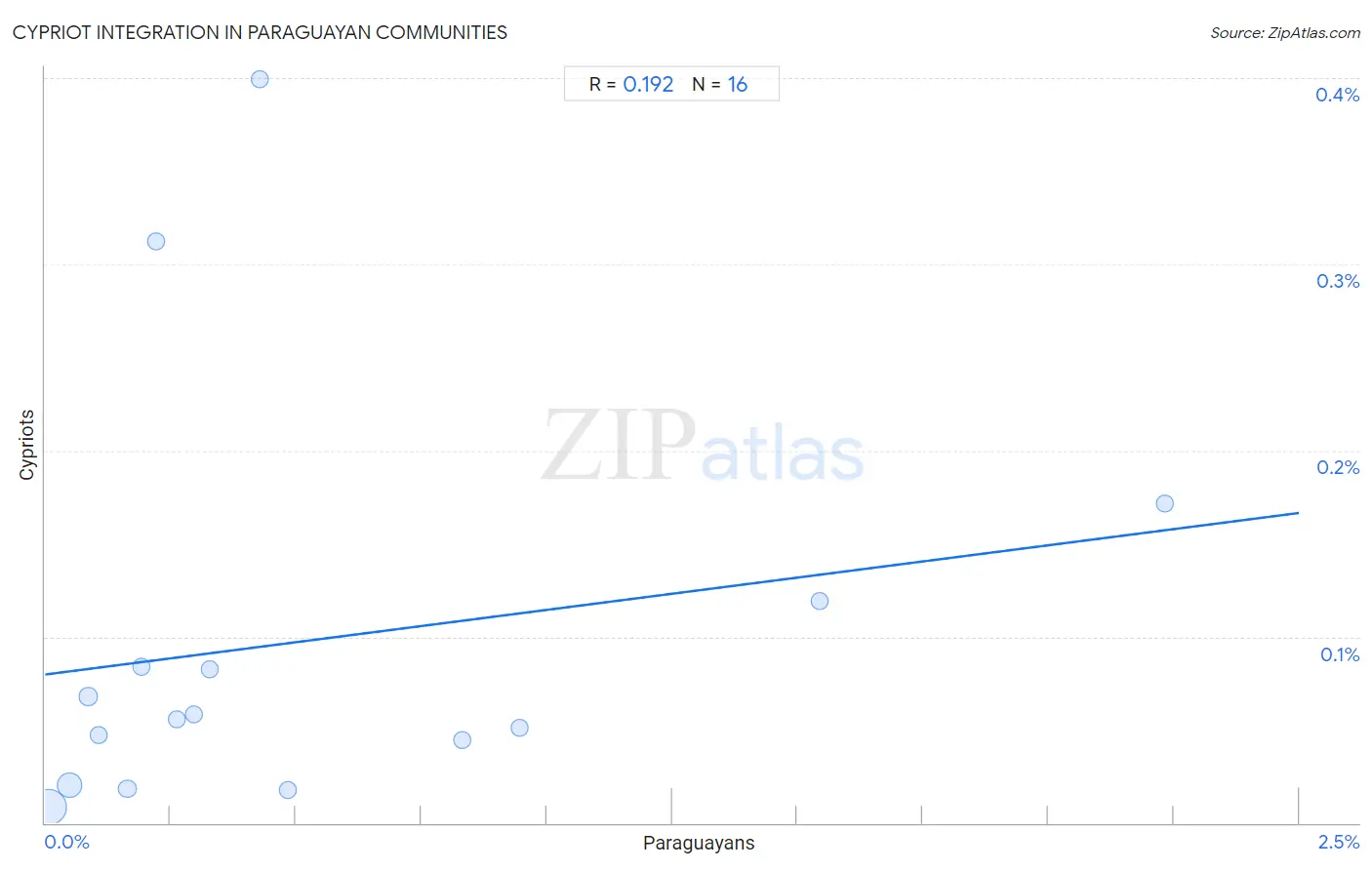
Paraguayan vs Cypriot Income
When considering income, the most significant differences between Paraguayan and Cypriot communities in the United States are seen in householder income ages 45 - 64 years ($109,447 compared to $123,396, a difference of 12.8%), median family income ($114,016 compared to $127,064, a difference of 11.4%), and householder income over 65 years ($64,443 compared to $71,714, a difference of 11.3%). Conversely, both communities are more comparable in terms of median female earnings ($43,173 compared to $45,570, a difference of 5.6%), wage/income gap (25.8% compared to 27.3%, a difference of 5.6%), and householder income under 25 years ($55,614 compared to $52,209, a difference of 6.5%).

| Income Metric | Paraguayan | Cypriot |
| Per Capita Income | Exceptional $50,385 | Exceptional $54,899 |
| Median Family Income | Exceptional $114,016 | Exceptional $127,064 |
| Median Household Income | Exceptional $95,737 | Exceptional $102,843 |
| Median Earnings | Exceptional $51,068 | Exceptional $54,589 |
| Median Male Earnings | Exceptional $59,975 | Exceptional $65,549 |
| Median Female Earnings | Exceptional $43,173 | Exceptional $45,570 |
| Householder Age | Under 25 years | Exceptional $55,614 | Average $52,209 |
| Householder Age | 25 - 44 years | Exceptional $106,615 | Exceptional $116,364 |
| Householder Age | 45 - 64 years | Exceptional $109,447 | Exceptional $123,396 |
| Householder Age | Over 65 years | Exceptional $64,443 | Exceptional $71,714 |
| Wage/Income Gap | Average 25.8% | Tragic 27.3% |
Paraguayan vs Cypriot Poverty
When considering poverty, the most significant differences between Paraguayan and Cypriot communities in the United States are seen in married-couple family poverty (5.1% compared to 4.1%, a difference of 24.3%), receiving food stamps (10.7% compared to 8.9%, a difference of 20.3%), and child poverty among girls under 16 (15.0% compared to 13.2%, a difference of 13.7%). Conversely, both communities are more comparable in terms of female poverty among 18-24 year olds (19.4% compared to 19.3%, a difference of 0.27%), single female poverty (19.3% compared to 19.2%, a difference of 0.35%), and single male poverty (11.6% compared to 11.7%, a difference of 0.60%).
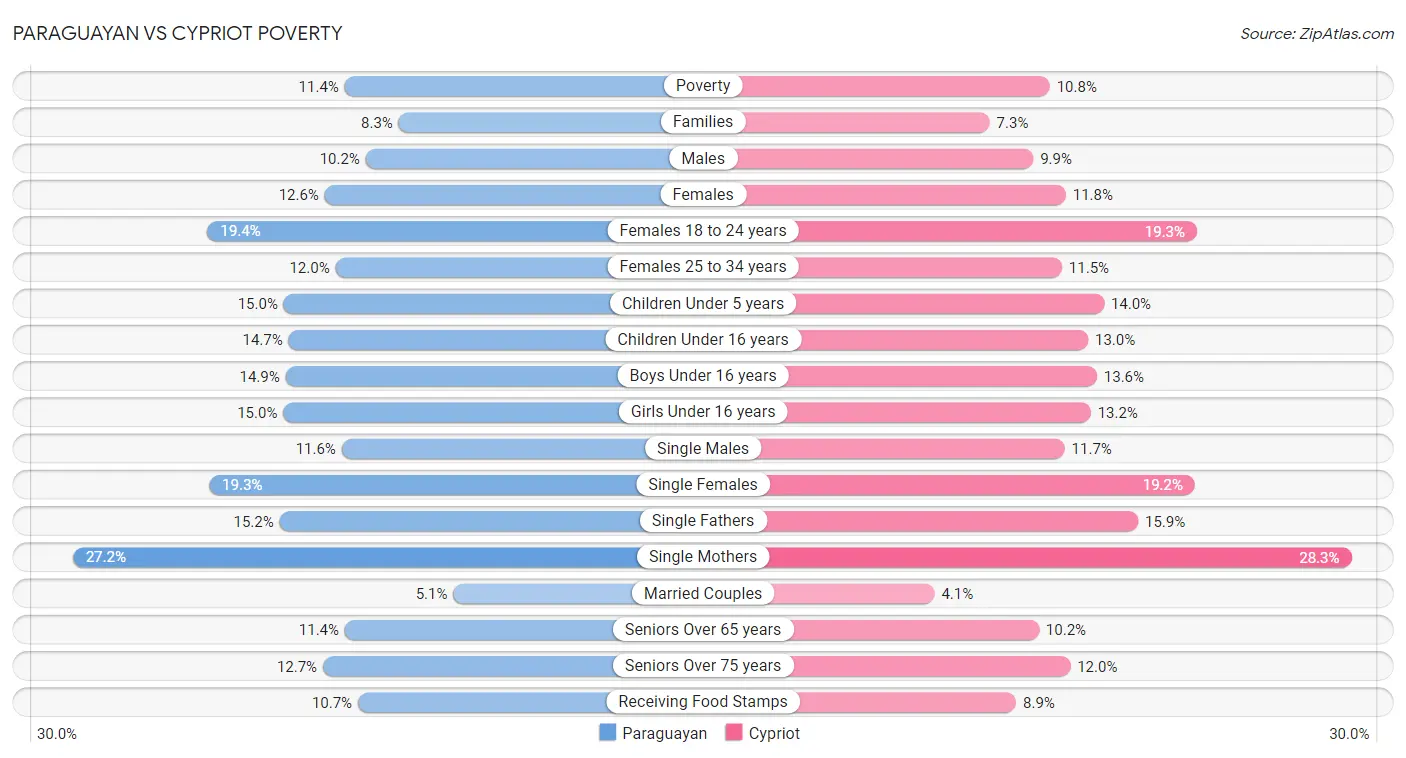
| Poverty Metric | Paraguayan | Cypriot |
| Poverty | Exceptional 11.4% | Exceptional 10.8% |
| Families | Exceptional 8.3% | Exceptional 7.3% |
| Males | Exceptional 10.2% | Exceptional 9.9% |
| Females | Exceptional 12.6% | Exceptional 11.8% |
| Females 18 to 24 years | Exceptional 19.4% | Exceptional 19.3% |
| Females 25 to 34 years | Exceptional 12.0% | Exceptional 11.5% |
| Children Under 5 years | Exceptional 15.0% | Exceptional 14.0% |
| Children Under 16 years | Exceptional 14.7% | Exceptional 13.0% |
| Boys Under 16 years | Exceptional 14.9% | Exceptional 13.6% |
| Girls Under 16 years | Exceptional 15.0% | Exceptional 13.2% |
| Single Males | Exceptional 11.6% | Exceptional 11.7% |
| Single Females | Exceptional 19.3% | Exceptional 19.2% |
| Single Fathers | Exceptional 15.2% | Excellent 15.9% |
| Single Mothers | Exceptional 27.2% | Exceptional 28.3% |
| Married Couples | Good 5.1% | Exceptional 4.1% |
| Seniors Over 65 years | Poor 11.4% | Exceptional 10.2% |
| Seniors Over 75 years | Poor 12.7% | Good 12.0% |
| Receiving Food Stamps | Exceptional 10.7% | Exceptional 8.9% |
Paraguayan vs Cypriot Unemployment
When considering unemployment, the most significant differences between Paraguayan and Cypriot communities in the United States are seen in unemployment among women with children ages 6 to 17 years (10.2% compared to 8.4%, a difference of 21.4%), unemployment among seniors over 75 years (8.7% compared to 7.4%, a difference of 17.4%), and unemployment among ages 60 to 64 years (4.7% compared to 5.4%, a difference of 14.9%). Conversely, both communities are more comparable in terms of unemployment among youth under 25 years (11.7% compared to 11.7%, a difference of 0.070%), unemployment (4.9% compared to 4.9%, a difference of 0.31%), and unemployment among seniors over 65 years (5.4% compared to 5.4%, a difference of 1.2%).
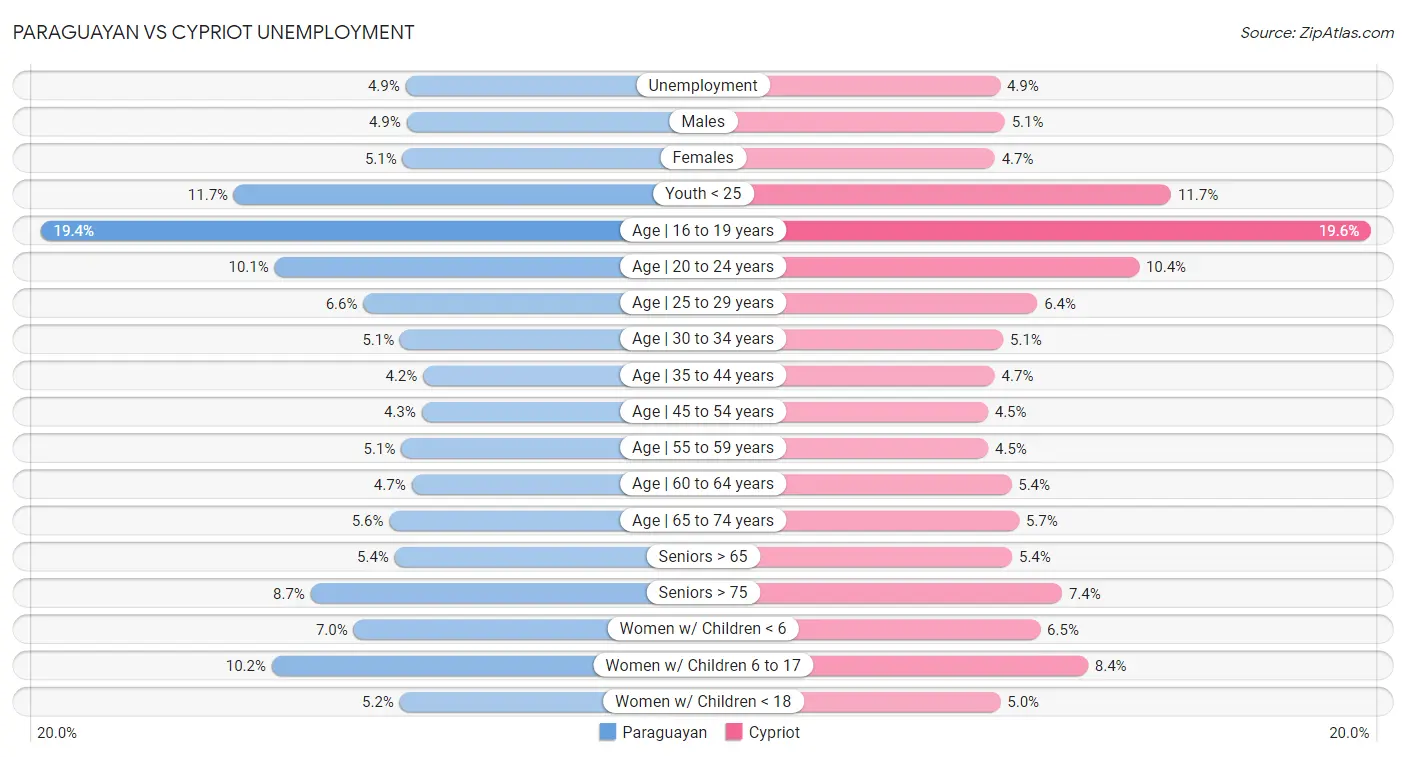
| Unemployment Metric | Paraguayan | Cypriot |
| Unemployment | Exceptional 4.9% | Exceptional 4.9% |
| Males | Exceptional 4.9% | Excellent 5.1% |
| Females | Exceptional 5.1% | Exceptional 4.7% |
| Youth < 25 | Fair 11.7% | Fair 11.7% |
| Age | 16 to 19 years | Tragic 19.4% | Tragic 19.6% |
| Age | 20 to 24 years | Excellent 10.1% | Poor 10.4% |
| Age | 25 to 29 years | Good 6.6% | Exceptional 6.4% |
| Age | 30 to 34 years | Exceptional 5.1% | Exceptional 5.1% |
| Age | 35 to 44 years | Exceptional 4.2% | Fair 4.7% |
| Age | 45 to 54 years | Exceptional 4.3% | Good 4.5% |
| Age | 55 to 59 years | Tragic 5.1% | Exceptional 4.5% |
| Age | 60 to 64 years | Exceptional 4.7% | Tragic 5.4% |
| Age | 65 to 74 years | Tragic 5.6% | Tragic 5.7% |
| Seniors > 65 | Tragic 5.4% | Tragic 5.4% |
| Seniors > 75 | Good 8.7% | Exceptional 7.4% |
| Women w/ Children < 6 | Exceptional 7.0% | Exceptional 6.5% |
| Women w/ Children 6 to 17 | Tragic 10.2% | Exceptional 8.4% |
| Women w/ Children < 18 | Exceptional 5.2% | Exceptional 5.0% |
Paraguayan vs Cypriot Labor Participation
When considering labor participation, the most significant differences between Paraguayan and Cypriot communities in the United States are seen in in labor force | age > 16 (66.5% compared to 65.5%, a difference of 1.5%), in labor force | age 45-54 (83.5% compared to 84.1%, a difference of 0.64%), and in labor force | age 20-24 (73.7% compared to 73.3%, a difference of 0.55%). Conversely, both communities are more comparable in terms of in labor force | age 30-34 (85.8% compared to 85.8%, a difference of 0.0%), in labor force | age 16-19 (33.8% compared to 33.8%, a difference of 0.010%), and in labor force | age 25-29 (85.9% compared to 85.8%, a difference of 0.10%).

| Labor Participation Metric | Paraguayan | Cypriot |
| In Labor Force | Age > 16 | Exceptional 66.5% | Excellent 65.5% |
| In Labor Force | Age 20-64 | Exceptional 80.6% | Exceptional 80.2% |
| In Labor Force | Age 16-19 | Tragic 33.8% | Tragic 33.8% |
| In Labor Force | Age 20-24 | Tragic 73.7% | Tragic 73.3% |
| In Labor Force | Age 25-29 | Exceptional 85.9% | Exceptional 85.8% |
| In Labor Force | Age 30-34 | Exceptional 85.8% | Exceptional 85.8% |
| In Labor Force | Age 35-44 | Exceptional 85.4% | Exceptional 85.2% |
| In Labor Force | Age 45-54 | Exceptional 83.5% | Exceptional 84.1% |
Paraguayan vs Cypriot Family Structure
When considering family structure, the most significant differences between Paraguayan and Cypriot communities in the United States are seen in single mother households (5.8% compared to 5.1%, a difference of 13.9%), single father households (2.1% compared to 1.8%, a difference of 11.5%), and births to unmarried women (29.7% compared to 27.0%, a difference of 9.8%). Conversely, both communities are more comparable in terms of currently married (47.2% compared to 47.8%, a difference of 1.3%), family households (64.1% compared to 63.2%, a difference of 1.4%), and average family size (3.20 compared to 3.14, a difference of 2.0%).

| Family Structure Metric | Paraguayan | Cypriot |
| Family Households | Fair 64.1% | Tragic 63.2% |
| Family Households with Children | Tragic 27.1% | Tragic 25.9% |
| Married-couple Households | Good 47.0% | Exceptional 48.0% |
| Average Family Size | Poor 3.20 | Tragic 3.14 |
| Single Father Households | Exceptional 2.1% | Exceptional 1.8% |
| Single Mother Households | Exceptional 5.8% | Exceptional 5.1% |
| Currently Married | Good 47.2% | Exceptional 47.8% |
| Divorced or Separated | Exceptional 11.5% | Exceptional 10.5% |
| Births to Unmarried Women | Exceptional 29.7% | Exceptional 27.0% |
Paraguayan vs Cypriot Vehicle Availability
When considering vehicle availability, the most significant differences between Paraguayan and Cypriot communities in the United States are seen in no vehicles in household (14.4% compared to 15.7%, a difference of 9.1%), 4 or more vehicles in household (4.9% compared to 5.0%, a difference of 1.8%), and 1 or more vehicles in household (85.7% compared to 84.4%, a difference of 1.6%). Conversely, both communities are more comparable in terms of 3 or more vehicles in household (16.6% compared to 16.6%, a difference of 0.41%), 2 or more vehicles in household (50.3% compared to 50.6%, a difference of 0.44%), and 1 or more vehicles in household (85.7% compared to 84.4%, a difference of 1.6%).

| Vehicle Availability Metric | Paraguayan | Cypriot |
| No Vehicles Available | Tragic 14.4% | Tragic 15.7% |
| 1+ Vehicles Available | Tragic 85.7% | Tragic 84.4% |
| 2+ Vehicles Available | Tragic 50.3% | Tragic 50.6% |
| 3+ Vehicles Available | Tragic 16.6% | Tragic 16.6% |
| 4+ Vehicles Available | Tragic 4.9% | Tragic 5.0% |
Paraguayan vs Cypriot Education Level
When considering education level, the most significant differences between Paraguayan and Cypriot communities in the United States are seen in no schooling completed (2.2% compared to 1.7%, a difference of 23.5%), professional degree (5.9% compared to 6.9%, a difference of 18.3%), and master's degree (18.8% compared to 21.8%, a difference of 15.8%). Conversely, both communities are more comparable in terms of nursery school (97.9% compared to 98.3%, a difference of 0.38%), kindergarten (97.9% compared to 98.3%, a difference of 0.38%), and 1st grade (97.9% compared to 98.2%, a difference of 0.38%).
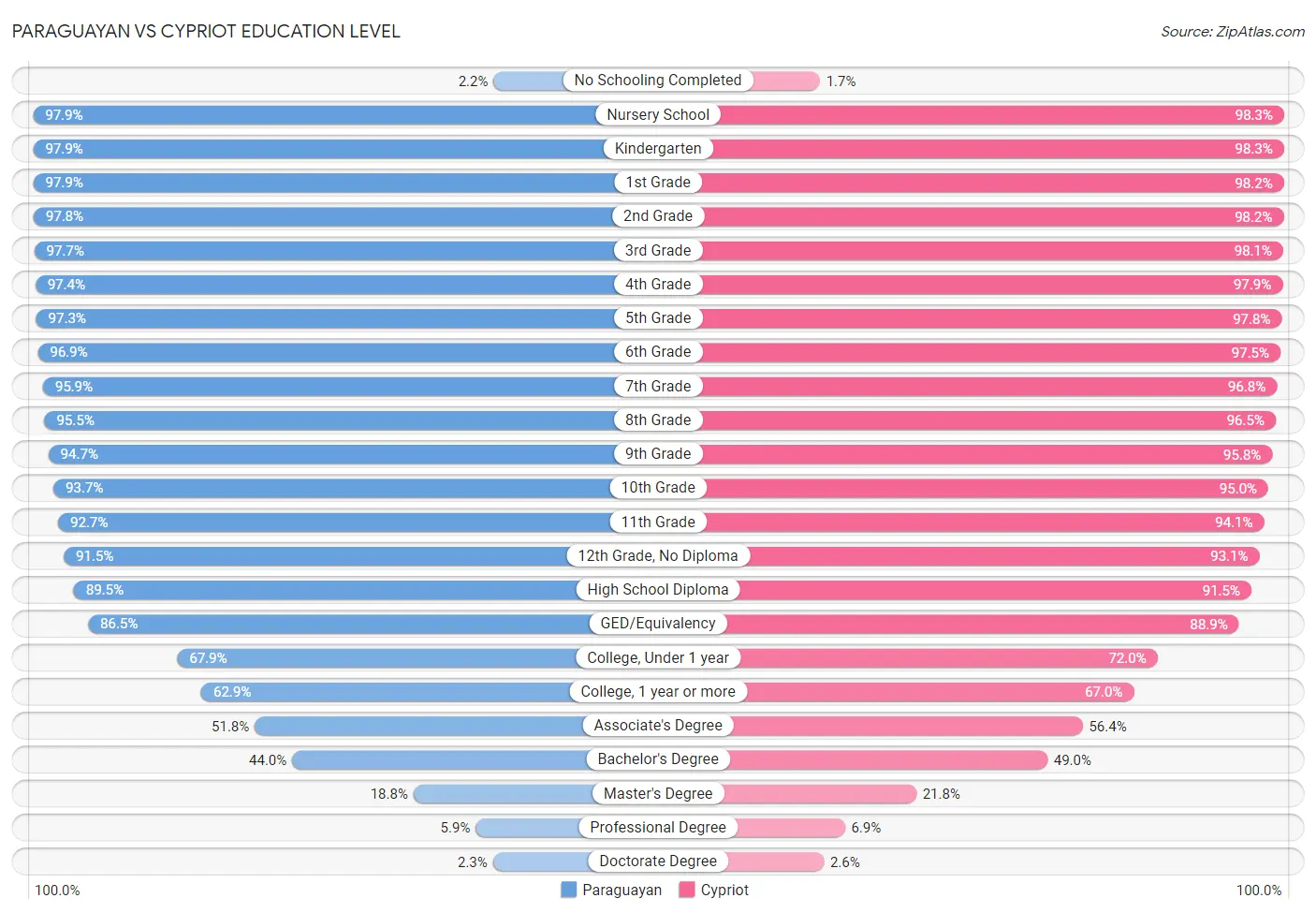
| Education Level Metric | Paraguayan | Cypriot |
| No Schooling Completed | Fair 2.2% | Exceptional 1.7% |
| Nursery School | Fair 97.9% | Exceptional 98.3% |
| Kindergarten | Fair 97.9% | Exceptional 98.3% |
| 1st Grade | Fair 97.9% | Exceptional 98.2% |
| 2nd Grade | Fair 97.8% | Exceptional 98.2% |
| 3rd Grade | Fair 97.7% | Exceptional 98.1% |
| 4th Grade | Fair 97.4% | Exceptional 97.9% |
| 5th Grade | Fair 97.3% | Exceptional 97.8% |
| 6th Grade | Fair 96.9% | Exceptional 97.5% |
| 7th Grade | Fair 95.9% | Exceptional 96.8% |
| 8th Grade | Fair 95.5% | Exceptional 96.5% |
| 9th Grade | Fair 94.7% | Exceptional 95.8% |
| 10th Grade | Average 93.7% | Exceptional 95.0% |
| 11th Grade | Good 92.7% | Exceptional 94.1% |
| 12th Grade, No Diploma | Good 91.5% | Exceptional 93.1% |
| High School Diploma | Good 89.5% | Exceptional 91.5% |
| GED/Equivalency | Excellent 86.5% | Exceptional 88.9% |
| College, Under 1 year | Exceptional 67.9% | Exceptional 72.0% |
| College, 1 year or more | Exceptional 62.9% | Exceptional 67.0% |
| Associate's Degree | Exceptional 51.8% | Exceptional 56.4% |
| Bachelor's Degree | Exceptional 44.0% | Exceptional 49.0% |
| Master's Degree | Exceptional 18.8% | Exceptional 21.8% |
| Professional Degree | Exceptional 5.9% | Exceptional 6.9% |
| Doctorate Degree | Exceptional 2.3% | Exceptional 2.6% |
Paraguayan vs Cypriot Disability
When considering disability, the most significant differences between Paraguayan and Cypriot communities in the United States are seen in disability age under 5 (2.0% compared to 1.3%, a difference of 53.3%), hearing disability (2.7% compared to 2.8%, a difference of 5.9%), and disability age 35 to 64 (9.8% compared to 9.4%, a difference of 5.0%). Conversely, both communities are more comparable in terms of female disability (11.2% compared to 11.2%, a difference of 0.30%), male disability (10.1% compared to 10.0%, a difference of 0.45%), and disability (10.6% compared to 10.6%, a difference of 0.59%).
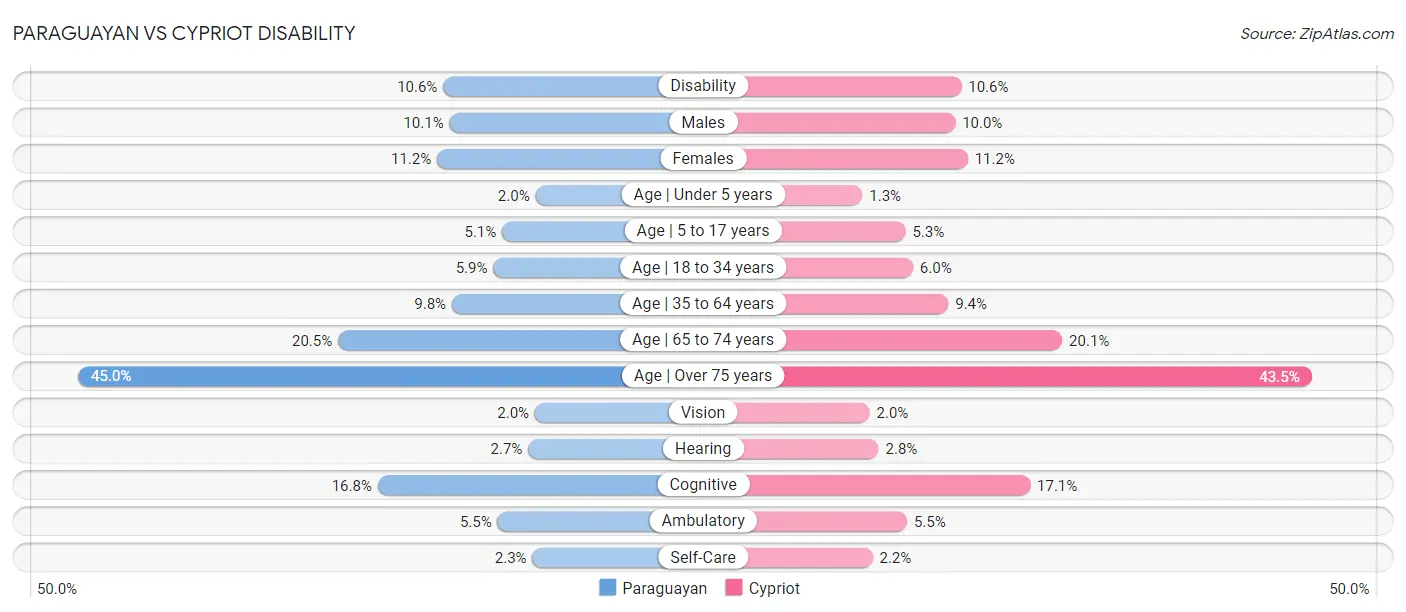
| Disability Metric | Paraguayan | Cypriot |
| Disability | Exceptional 10.6% | Exceptional 10.6% |
| Males | Exceptional 10.1% | Exceptional 10.0% |
| Females | Exceptional 11.2% | Exceptional 11.2% |
| Age | Under 5 years | Tragic 2.0% | Poor 1.3% |
| Age | 5 to 17 years | Exceptional 5.1% | Exceptional 5.3% |
| Age | 18 to 34 years | Exceptional 5.9% | Exceptional 6.0% |
| Age | 35 to 64 years | Exceptional 9.8% | Exceptional 9.4% |
| Age | 65 to 74 years | Exceptional 20.5% | Exceptional 20.1% |
| Age | Over 75 years | Exceptional 45.0% | Exceptional 43.5% |
| Vision | Exceptional 2.0% | Exceptional 2.0% |
| Hearing | Exceptional 2.7% | Exceptional 2.8% |
| Cognitive | Exceptional 16.8% | Excellent 17.1% |
| Ambulatory | Exceptional 5.5% | Exceptional 5.5% |
| Self-Care | Exceptional 2.3% | Exceptional 2.2% |